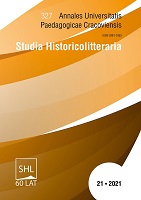Ekspresja i empatia. Tauromachia okiem Reymonta… (Los toros)
Expression and empathy. Tauromachia as seen by Reymont (Los toros)
Author(s): Dorota Samborska-KukućSubject(s): Cultural history, Customs / Folklore, Polish Literature, Culture and social structure , Theory of Literature
Published by: Wydawnictwo Uniwersytetu Komisji Edukacji Narodowej w Krakowie
Keywords: W. S. Reymont; Los toros; Spain; a corrida (a bullfight);
Summary/Abstract: Reymont wrote the short story, Los toros, in the year 1907 after coming back from Spain, where he witnessed a corrida in San Sebastián. The choice of the genre was intentional. The writer used it to reflect the realities of life and depict a group portrait of Spaniards, in which he succeeded without a doubt, using all with his literary imagination and ability to make his works metaphoric. Baffled by the corrida as an element of Spanish culture, Reymont did not express his moral approval of torturing animals (bulls and horses) on stage. On the contrary, his narration is full of sympathy and expressions that indicate emotional engagement. The turning point, the act of pardon performed by the young shepherd and the narrator’s friend towards the bull, indicates that Reymont’s reception of the corrida was empathic. Now, we had two conclusions on the contesting of the phenomenon. Reymont’s work was used by the French Chamber of Deputies as a literary example of disapproval of bloody spectacles that are justified by tradition.
Journal: Annales Universitatis Paedagogicae Cracoviensis. Studia Historicolitteraria
- Issue Year: 2021
- Issue No: 21
- Page Range: 221-234
- Page Count: 14
- Language: Polish

